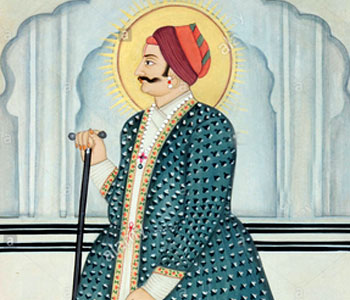 Jaipur history is truly captivating. Jaipur, the Pink Glory of India, was formed as a city in 1727. Much before that, in 12th century, the Kanchchwaha kinfolk of Rajputs arrived at the Old Fort palace of the Aravalli valley, Ambar Fort. The Kanchchwahas used to claim their origin as the successors of Kush, one of the sons of Lord Rama. Now that's a controversial part of the story but what these Kanchchwahas did was gathered a lot of power with the help of their ever-shining swords. They were ambitious, dreamy, and aggressive in nature and they compromised on nothing to ensure their victory. Thus the glorious history of Jaipur started its sojourn.
Jaipur history is truly captivating. Jaipur, the Pink Glory of India, was formed as a city in 1727. Much before that, in 12th century, the Kanchchwaha kinfolk of Rajputs arrived at the Old Fort palace of the Aravalli valley, Ambar Fort. The Kanchchwahas used to claim their origin as the successors of Kush, one of the sons of Lord Rama. Now that's a controversial part of the story but what these Kanchchwahas did was gathered a lot of power with the help of their ever-shining swords. They were ambitious, dreamy, and aggressive in nature and they compromised on nothing to ensure their victory. Thus the glorious history of Jaipur started its sojourn.
Maharaja Sawai Jai Singh II, the ruler of Jaipur was a feudatory of the Mughals and received the title of 'Sawai' (that literally means one and a quarter) from Emperor Aurangzeb, who declared him a quarter superiority to his famous forbearer Mirza Raja Jai Singh (d. 1667) after he took over the Fort of Vishalgarh from the Marathas in 1701. An Imperial Edict officially recognized the title of Maharaja Sawai Jai Singh II in 1712. The rulers of Jaipur began the practice of flying two flags, one full and one quarter-sized to commemorate the event. After the death of Aurangzeb in 1707, the Mughal Empire slowly declined and the Delhi Court became the most obvious seat of intrigues and treacherous politics.
In 1719 when, after surviving the treacherous assassination attempts and other diverse opposition, the nineteen-year old Muhammad Shah became the Emperor that some sort of steadiness was achieved. His reign lasted for the next twenty years until the Afghan invader Nadir Shah plundered Delhi in 1739 and along with other precious items, carried away the famous Peacock Throne. The perceptive and opportunistic Maharaja Sawai Jai Singh II managed to keep hold of his political importance during these chaotic times. His proficient diplomacy had managed to keep him in Aurangzeb's good eyes and he remained a favorite too with Muhammad Shah.
Muhammad Shah encouraged that the new Emperor to abolish the Jaziya tax that were imposed on the Hindus. After bringing to the Emperor's notice some astronomic disagreements that possibly affected the timings of Hindu and Muslim divine events and expressing his yearning to correct these. Maharaja Sawai Jai Singh II also received Imperial backing for building his Astronomy Observatories at Delhi, Jaipur, Varanasi, Ujjain and Mathura. Jai Singh titled the astronomical work he completed in 1728 as 'Zij-e-Muhammad-Shahi as a tribute to his Mughal patron.
 In 1728, Maharaja Sawai Jai Singh II built his new, magnificently designed capital Jaipur, lying about 200 km southwest of Delhi and constructed by combining the features of the ancient Hindu treatise on architecture, the Shilpa Shastra and plans of many European cities of the time with his own ideas. Jaipur was built according to a specific planning of grid system with nine rectangular zones corresponding to the nine divisions of the universe. The European travelers of the time, like the English bishop, Heber and the Frenchman Louis Rousselet were greatly impressed by Jai Singh Maharaja Sawai Jai Singh II's unmatched excellence in city planning.
In 1728, Maharaja Sawai Jai Singh II built his new, magnificently designed capital Jaipur, lying about 200 km southwest of Delhi and constructed by combining the features of the ancient Hindu treatise on architecture, the Shilpa Shastra and plans of many European cities of the time with his own ideas. Jaipur was built according to a specific planning of grid system with nine rectangular zones corresponding to the nine divisions of the universe. The European travelers of the time, like the English bishop, Heber and the Frenchman Louis Rousselet were greatly impressed by Jai Singh Maharaja Sawai Jai Singh II's unmatched excellence in city planning.
Astronomy, however, was Maharaja Sawai Jai Singh II's real passion. He was a scholar, with a miscellaneous collection of astronomical manuscripts and tables from Arabia and Europe, such as the Englishman John Flamsteed's 'Historia Coelestis Britannica', the Portuguese Pere de la Hire's 'Tabulae Astronomicae', the Turkish royal astronomer, Ulugh Beg's tables 'Zij Ulugh Begi', and the Greek Ptolemy's 'Almagest'. With the help of Pandit Jagannath, a linguist Marathi Brahmin, he had these treatises translated into Sanskrit and they were given Sanskrit names. For example, Ulugh Beg's tables were given the name 'Turusurni', Ptolemy's treatise became Siddhantasurikaustubh', and la Hire's tables 'Mithiajeevachayyasurni'. Maharaja Sawai Jai Singh II also acquired different kinds of telescopes from Europe, and started to research on observations using astrolabes and other instruments. With these Maharaja Sawai Jai Singh II had detected the inconsistencies in the earlier astronomy tables that had occurred due to changes in the positions of the heavenly bodies.
Maharaja Sawai Jai Singh II 's observatories were called 'Jantar Mantars' and in Sanskrit, it translates to 'The Formula of Instruments'. The first Jantar Mantars was built at Delhi in 1724, the second at Jaipur in 1734 and the other smaller ones at Mathura, Ujjain and Varanasi between 1732 and 1734. These monumentally grand, supernatukar structures, with their significant geometric shapes are themselves the astronomical instruments, well equipped with drafting devices and grid indicators. These sophisticated devices can exactly measure the planetary positions and read the time accurate to one second. Jai Singh had more faith in the accuracy of his huge masonry structures. Maharaja Sawai Jai Singh II also himself designed some of the instruments, like the 'Ram Yantra', 'Samrat Yantra', and 'Jai Prakash Yantra'. He also set up an astrolabe, the 'Raj Yantra'. This is a map of planetary positions portrayed on a 7-foot wide metal disc, and he devoted two volumes of write up related to its practical use.
Maharaja Sawai Jai Singh II was far more accurate than Ptolemy and Ulugh Beg in measuring the motion of a spinning body in which it vibrates and thus causes the axis of rotation to sweep out a cone of the equinoxes, and the irregularity of the ecliptic. Maharaja Sawai Jai Singh II could not take into consideration many of the important European discoveries of his time, like Copernicus's heliocentric concept that maintained that it was the earth that moved around the sun and not the other way around.
Maharaja Sawai Jai Singh II opened his observatories to the public in order to promote the concept of astronomy, and also sponsored a scientific assignment to Portugal under the Jesuit, Padre Manuel de Figueredo. Jai Singh, on experimenting with the foreign apparatus, did not find it at its best and had many loop holes and did develop his astronomical work with some of Hire's theories, he again found several discrepancies in Hire's tables. Maharaja Sawai Jai Singh II asked for the opinions in 1734 of two Frenchmen stationed in Chandernagore in Bengal, Father Claude Boudier (1686-1757) and Pons, who confirmed the inaccuracies in Hire's tables that the king already saw. Maharaja Sawai Jai Singh II further sends a second delegation to Europe, but died before he could do so in 1743.
Maharaja Sawai Jai Singh II's astronomical enterprises faded away after him and one of the major reasons for this scientific disinterest is said to be the whole imperialistic structure of 18th Century Europe that depended on improved Navigational knowledge, invention and building of meticulous Astronomical instruments, the Indian States of that time felt no interest in this and looked upon Astronomy as just a past time. The Delhi Observatory by Maharaja Sawai Jai Singh II was greatly damaged in 1764 by Jawahar Singh, the son of the Jat ruler of Bharatpur, Suraj Mal, and only unsystematically restored in 1910 by the then Raja of Jaipur for the 1911 royal tour of King George V. The Jaipur Observatory was later transformed into a gun factory by Maharaja Sawai Jai Singh II's grandson and was excellently repaired under the direction of Chandra Dhar Sharma Guleri in 1901. Today, Maharaja Sawai Jai Singh II's Jantar Mantars have become tourist spots and are well-worth a visit.







